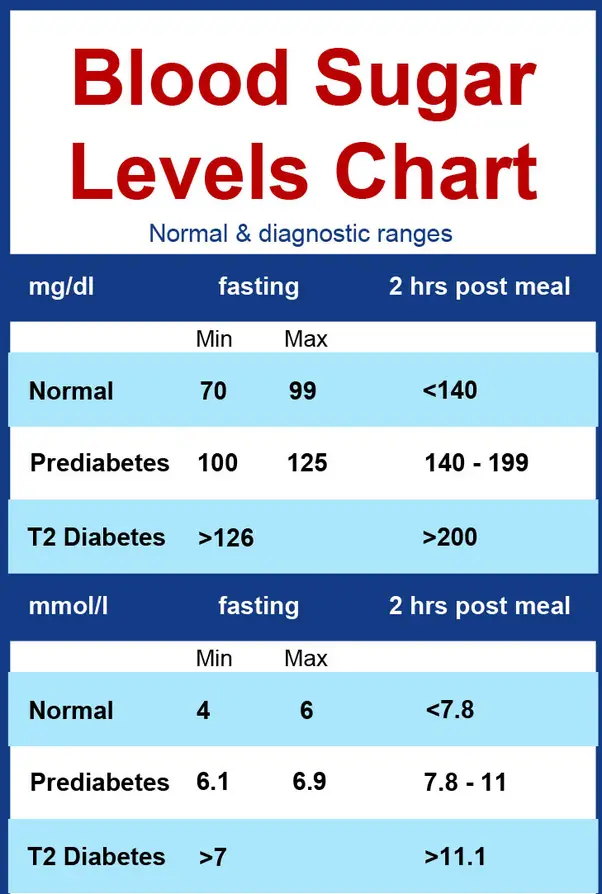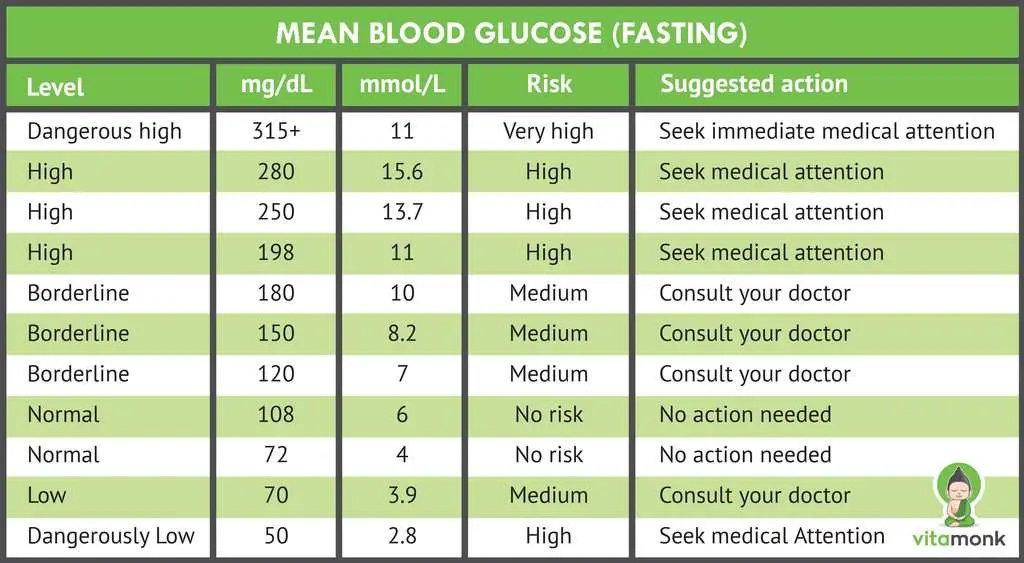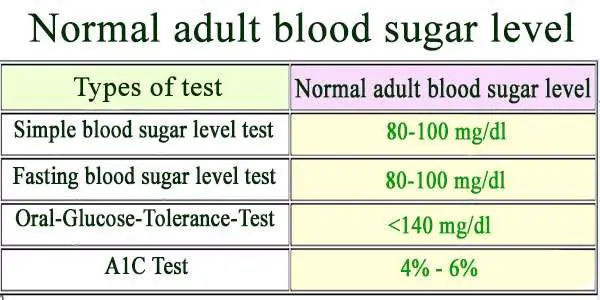What Is A Normal Blood Sugar Level
The answer to the question what is a normal blood sugar level is as follows:
Fasting normal blood sugarNormal for person without diabetes: 7099 mg/dl Official ADA recommendation for someone with diabetes: 80130 mg/dl
Normal blood sugar 2 hours after mealsNormal for person without diabetes: Less than 140 mg/dl Official ADA recommendation for someone with diabetes: Less than 180 mg/dl
Normal for person without diabetes: Less than 5.7%Official ADA recommendation for someone with diabetes: Less than 7.0%
Recommended Reading: Nph Insulin Interactions
People Who Are Obese Are More Likely To Develop Type 2 Diabetes
Those with increased body fat are at higher risk for type 2 diabetes. Risk is greatest for those with excess fat carried around the waist. These people are also at increased risk for hypertension, high cholesterol levels, and heart disease compared with those who are lean or carry fat around the hips.
Who Is Most At Risk For Developing Diabetes
The following categories of people are considered “high-risk” candidates for developing diabetes:
- Individuals who are overweight or obese
- Individuals who are 45 years of age or older
- Individuals with first-degree relatives with diabetes
- Individuals who are African-American, Alaska Native, American Indian, Asia American, Hispanic/Latino, Native Hawaiian, Pacific Islanders,
- Women who developed diabetes while they were pregnant or gave birth to large babies
- Individuals with high blood pressure
- Individuals with high-density lipoprotein below 25 mg/dl or triglyceride levels at or above 250 mg/dl
- Individuals who have impaired fasting glucose or impaired glucose tolerance
- Individuals who are physically inactive engaging in exercise less than three times a week
- Individuals who have polycystic ovary syndrome, also called PCOS
- Individuals who have acanthosis nigricans — dark, thick and velvety skin around your neck or armpits
In addition to testing the above individuals at high risk, the American Diabetes Association also recommends screening all individuals age 45 and older.
Don’t Miss: Drinking Alcohol While Intermittent Fasting
Eat Healthy Foods And Follow A Regular Eating Schedule
Following a healthy diet as recommended by your diabetes team, watching portion sizes, and not skipping meals can help to prevent side effects like low blood sugar that can occur while taking glipizide. Notify your healthcare providers if you are not able to eat because you are sick or because you will be having a surgery or procedure done.
Why Your Blood Sugar Level May Be Low

If blood sugar drops below 70 mg/dL, it is below normal levels. This can be caused by a variety of factors, such as:
- Not eating enough or missing a meal or snack
- Reducing the amount of carbohydrates you normally eat
- Alcohol consumption especially if youre drinking on an empty stomach
- Taking too much insulin or oral diabetes medication based on carbohydrates or activity levels
- Increased physical activity
- Side effects from medications
If you have diabetes, keep your blood glucose meter and sources of fast-acting glucose close by in case your blood sugar drops. This is especially important for people with hypoglycemia unawareness, which is a condition that causes symptoms of low blood sugar to go unnoticed.
Eating balanced meals and snacks at regular times throughout the day is a big part of maintaining normal blood glucose levels. Check out our article on meal planning for diabetes to better understand the three macronutrients where calories come from and which have the biggest effect on blood sugar.
Meal Planning for Diabetes: How to Optimize Your Diet >
Everyone will respond differently to certain factors, which is why its important to have individualized target glucose levels. To help you reach your target blood glucose goals, work with your healthcare provider to discuss modifications to your diet, physical activity, or medications, and alert them of other factors like a recent illness or stressful event.
Read Also: What Is 14 10 Intermittent Fasting
High Blood Sugar: Hidden Dangers
In the short term, high blood sugar levels can zap your energy, cause excessive thirst and urination, and blur your vision. High blood sugar levels can also lead to dehydration, dry and itchy skin, and infections. Minimizing the time spent above your target blood sugar range can help you feel your best and will help prevent complications and injury to your body.
Over time, high blood sugar affects many parts of the body. Chronic high blood sugar can start to cause noticeable changes, including:
- Memory problems
- Vision problems like blurriness, diabetic retinopathy, and blindness
- Gum disease that leads to tooth loss, which can make eating healthy foods difficult due to problems chewing
- Heart attack and stroke due to increased plaque build-up in the vessels and other vascular issues
- Kidney disease, which can lead to the need for dialysis or a kidney transplant
- Nerve damage that can cause decreased sensation in the feet and legs which increases the risk for wounds to turn into serious infections and even amputation
Nerve damage from high blood sugar can also cause a variety of symptoms including:
- Pain and tingling in the feet and hands
- Difficulty emptying your bladder
- Problems during the digestion process after eating, which can cause food to sit in the stomach too long and lead to nausea, vomiting, and erratic blood sugar levels
Checking your blood sugar frequently and taking immediate action when it is above range can reduce your risk of complications.
What Can You Do To Maintain Your Blood Glucose Levels
A good start in how to keep normal blood sugar is How can you decrease your blood sugar levels in this short article. Dont consume foods large in carbs and sugar such as buttered potatoes, fatty foods, sweet, and sweet desserts like cake with icing. Diet plan adjustment is a major step in your management of diabetes. Use a blood glucose log book with the date, time, and values of your or you and your medical professional to help you manage your type 1 diabetes or type 2 diabetes, and use a blood sugar home test set to get glucose test outcomes. In addition, log any modification in signs in time. The log book will equip you and your doctor to change treatments and actions to acquire the very best management of your diabetes.
Don’t Miss: Intermittent Fasting And Alcohol
Level Of Blood Glucose In Adults:
The normal glucose level range from 100-180 mg/dL in a day. Generally, when they wake up after fasting for around 7-8 hours the sugar level in blood is at the lowest. The normal fasting blood sugar level can be less than 100mg/dL. After 2 hours of having meal, the blood glucose level ranges between 90 to 110 mg/dL.
Blood Sugar Levels Of Children With Diabetes:
Summary
In diabetic children, the healthy blood sugar levels are between 70 to 180 mg/dL.
Recommended Reading: Can You Drink Alcohol While Intermittent Fasting
The Best Healthcare Options To Prevent Diabetes
Health care is expensive. Canada spent an estimated $253.5 billion in 2018, and as the cost of health care increases, so does the cost to you. Pre-existing medical conditions, family history, and BMI are all factors that increase the cost of health care. These factors also increase your risk of diabetes, so you must be covered.
Of course, as a Canadian, you are entitled to some free and subsidized health care, which is great. But many people opt for private healthcare and for diabetes prevention this can be very useful. If you’re shopping around for private healthcare, it’s important to choose the right package.
Basic health insurance will usually cover health care, medical services, and prescriptions, but they tend to lack customizations. If you opt for a premium/guaranteed health insurance you have the bonus of a custom plan based on your needs if you are worried about your risk of diabetes this is like gold dust.
Private healthcare plans can cover the cost of many expenses related to diabetes such as blood tests, blood sugar monitors, specialist referrals, hospital stays, and much more! The most important thing to note about private health care is that it covers costs for preventative care, not just treatment for diseases.
There are many different options available, so make sure you search for the best quotes.
What If The Range Of Your Fasting Blood Sugar Levels Go Up 100 Mg/dl Chart Explained
The chart below will help you get an idea on what goes on in case of changing of fasting blood sugar levels up 100mg/dl and down 70 mg/dl.
When your fasting blood sugar level readings are between 100 and 125 mg/dl, then most probably you may have pre-diabetes.
That is a condition in which your body insulin function is impaired. You may know it also as impaired fasting blood glucose condition.
In case your fasting blood sugar levels figures are higher than 125 mg/dl, than most probably you may have diabetes. Further diagnostic exams will determine what type of diabetes you may have.
Remember: always will be a double check to fully determine if you have diabetes or not.
This means that you’ve to monitor your fasting blood sugar levels for one week, record the results for reference when consulting your doctor. Then, and only then you will know if you are diabetic or not.
You May Like: Is 119 High For Fasting Blood Sugar
Normal Blood Sugar Levels For School
School-aged children should have blood sugar levels that range from 80 to 180 mg/dL. Understanding how food, exercise, stress, and growth hormones can affect their blood sugar levels is important for managing their blood sugar. Here are the daily normal levels for school-aged children:
- After fasting for 8-hours
- Before a meal
- 1-2 hours after eating
- Bedtime
What Should My Bgl Be

For a person without diabetes, throughout the day blood glucose levels will generally range between 4.0 7.8 millimoles of glucose per litre of blood regardless of how they eat or exercise, or what stress theyre under.
When youre living with diabetes your body cannot, or finds it hard to, keep your BGLs within a healthy range.
Because each person living with diabetes is different, your GP or specialist will set target BGLs that are right for you. However, here is some information you can use as a general guide.
Don’t Miss: Is 119 High For Fasting Blood Sugar
Talk To Your Doctor Or Nurse
If you use insulin and your blood sugar is frequently or consistently low, ask your doctor or nurse if you:
- Are injecting your insulin the right way
- Need a different type of needle
- Should change how much insulin you take
- Should change the kind of insulin you take
DO NOT make any changes without talking to your doctor or nurse first.
Sometimes hypoglycemia can be due to taking the wrong medicines. Check your medicines with your pharmacist.
Blood Sugar Level Chart
- Normal reading for nondiabetic person = 7099 mg/dl
- The recommendation for someone who is diabetic = 80130 mg/dl
Two hours after a meal
- Normal reading for nondiabetic person = Below 140 mg/dl
- The recommendation for someone who is diabetic = Below 180 mg/dl
HbA1c
- Normal reading for nondiabetic person = Below 5.7%
- The recommendation for someone who is diabetic = 7% or less
**My Med Memo The measurement mmol is the abbreviation for millimole.
Recommended Reading: How Do I Unsubscribe From Dofasting
Managing Blood Sugar When Youre Ill
When you get sick, your blood sugar levels may fluctuate and become unpredictable.
If you’re sick, it’s very important that you:
- drink plenty of water or sugar-free fluids
- check your blood sugar levels more often than usual
- take 15 grams of carbohydrate every hour if you are not able to follow your usual meal plan
- replace food with fluids that contain sugar if you can’t eat solid food
- continue to take your insulin or other diabetes medication
If you have a cold or flu and want to use a cold remedy or cough syrup, ask your pharmacist to help you make a good choice. Many cold remedies and cough syrups contain sugar, so try to pick sugar-free products.
As an extra precaution, you should always check with your health-care team about guidelines for insulin adjustment or medication changes during an illness.
Causes Of High Blood Glucose
- The hormone, insulin, regulates blood glucose levels by stimulating various tissues to take up glucose from the blood. In this way it clears the blood of excess glucose. A deficiency or resistance of the bodys cell to insulin is one the main reasons for hyperglycemia.
- Certain drugs may produce hyperglycemia . Some examples of these hyperglycemia inducing drugs include corticosteroids, beta blockers, thiazide diuretics, niacin, protease inhibitors, amphetamine, olanzapine, duloxetine.
- Other than diabetes, conditions such as acute stress, myocardial infarction , stroke, pancreatic diseases, brain tumors and hormonal dysfunctions of adrenal, pituitary, and thyroid glands could also cause hyper-glycemia.
Dont Miss: Can Skinny People Get Diabetes
Don’t Miss: Should You Fast For An A1c Blood Test
Physical Exercise To Regulate Glucose
Your parent should try to exercise for 30 minutes at least four or five times per week, breaking down the workouts into ten- or fifteen-minute sessions based on his or her abilities and daily schedule. The best exercises for older adults who want to maintain normal glucose levels are cycling, walking, and swimming. These are movements that keep the heart pumping, burn calories, and help seniors maintain healthy blood sugar. Drinking water, eating healthy foods, and monitoring stress levels can also lower the risk of hyperglycemia.
A professional caregiver with training in nutrition and exercise can be an outstanding source of support for your senior loved one. Maintaining a high quality of life can be challenging for some seniors, but professional caregivers can help them obtain this goal. Families can trust senior care experts to help their elderly loved ones focus on lifestyle choices that increase the chances of living a longer and healthier life. Call Home Care Assistance today at 226-3737 to learn about our high-quality in-home care services.
Read Also: What Kind Of Ice Cream Can Diabetics Eat
Symptoms Of Low Blood Sugar
In contrast, hypoglycemic refers to when your blood sugar is too low. Common symptoms include irregular or fast heartbeat, shakiness, anxiety, pale skin, fatigue, hunger, sweating, irritability, and tingling/numbness in cheek, lips, or tongue. As it gets worse, you may also experience confusion, blurred vision, seizures, and loss of consciousness.
If you have diabetes, low blood sugar can happen if youre not taking enough medicine. Hypoglycemia is less common in people who dont have diabetes but it can happen. Things like certain medicines, excessive alcohol drinking, critical illness, and hormone deficiency can cause low blood sugar in individuals without diabetes.
Don’t Miss: What Is 14 10 Intermittent Fasting
Causes And Symptoms Of Diabetes
The values of blood glucose that are slightly higher than the normal values indicate higher risk of developing diabetes. This condition is known as prediabetes. Regular check ups help diagnose diabetes in early stage which helps control the disease with the help of modified diet, exercise, and medications. Frequent urination, increased wound healing time, increased thirst, strong hunger prangs, blurry vision, frequent infections, weight loss, excessive weakness, and changes in skin are some symptoms of diabetes. Obesity, high blood pressure, family history, insulin resistance, low insulin levels, high cholesterol and/or triglycerides levels, and lack of exercise are some of the common factors which can lead to diabetes.
What Happens During The Test

Most people can take an A1C test at any time without preparing beforehand. However, a doctor may sometimes request that a person avoids eating or drinking for 8 hours before the test.
Women who are pregnant may need to drink a sugary beverage 1 hour before the test.
A doctor or nurse will collect a blood sample, usually from a vein in the arm or hand. They will send the sample to a laboratory for analysis.
Also Check: Is 119 High For Fasting Blood Sugar
What Are Abnormal Glucose Levels And Why Do They Matter
Why is it unhealthy for glucose levels to be too high or too low ?
Hyperglycemia refers to elevated blood glucose levels. This usually occurs because the body does not appropriately remove glucose from the blood this can happen due to many complex reasons. Elevated glucose levels can damage blood vessels and nerves over time this can then lead to problems in the eyes, kidneys, and heart, as well as numbness in the hands and feet. Very high levels can lead to coma and even death in some cases. People with fasting glucose levels higher than 100 mg/dl have impaired glucose tolerance and should speak with their healthcare provider.
Some people may think that to avoid all these issues, they should just keep their blood glucose levels as low as possible. If too high is bad, then low must be good, right? Not exactly. When glucose gets too low, its called hypoglycemia. The threshold for hypoglycemia is typically thought to be when glucose falls below 70 mg/dl. When this happens, the body may release epinephrine , the fight or flight hormone, which can lead to a fast heart rate, sweating, anxiety, blurry vision, and confusion, but also helps the body mobilize glucose into the blood. If blood glucose levels stay too low for too long, it can cause seizures, coma, and in very rare instances, death.
You May Like: Thin Type 2 Diabetics